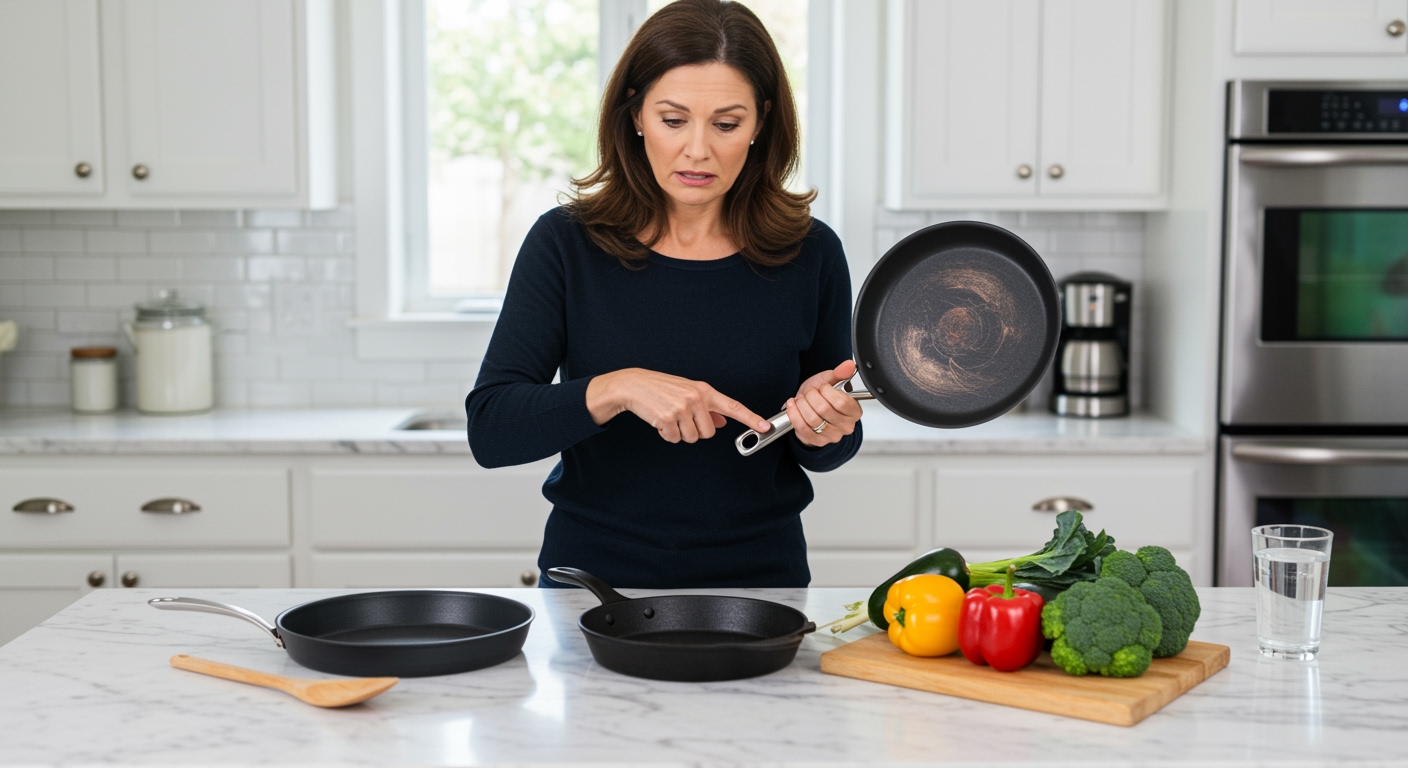✪ Key Takeaway: Damaged nonstick pans release toxic PFAS chemicals into food that accumulate in your body and cause serious health problems.
Introduction
You flip pancakes every Sunday morning using the same scratched nonstick pan your family has trusted for years.
Those tiny scratches and chips you ignore are actually releasing invisible toxins directly into your food with every meal you cook.
Hi, I’m Abdur, your nutrition coach and today I’m going to expose the hidden dangers lurking in your kitchen and show you how to protect your family from this silent threat.
What Toxic Chemicals Are Hiding In Your Nonstick Pan
Most nonstick pans contain a coating made from perfluoroalkyl substances commonly known as PFAS chemicals.
These synthetic compounds create the slippery surface that prevents food from sticking to your pan.
When the coating gets scratched or overheated above 500 degrees Fahrenheit, it begins to break down and release these toxic particles into your food.
PFAS chemicals are called forever chemicals because they never break down naturally in the environment or your body.
Once these substances enter your bloodstream through contaminated food, they accumulate in your liver, kidneys, and other vital organs over time.
Even small amounts consumed regularly can build up to dangerous levels that affect your health for decades.
✪ Fact: PFAS chemicals can remain in your body for 3 to 8 years after exposure stops completely.
How These Chemicals Damage Your Body From Inside
PFAS chemicals interfere with your body’s natural hormone production and immune system function.
These toxins bind to proteins in your blood and get transported to your thyroid gland, where they disrupt hormone balance.
Your liver tries to process these foreign chemicals but cannot break them down, causing them to accumulate and potentially damage liver cells over time.
Research shows that people with higher PFAS levels in their blood have increased risks of high cholesterol, kidney disease, and certain cancers.
These chemicals also weaken your immune response, making you more susceptible to infections and reducing vaccine effectiveness.
Pregnant women face additional risks because PFAS can cross the placenta and affect fetal development, potentially causing low birth weight and developmental delays.
Children are especially vulnerable because their developing bodies absorb and retain these toxic substances more readily than adults.
✪ Pro Tip: Blood tests can detect PFAS levels, but most doctors don’t routinely check for these chemicals.
Why Your Favorite Pan Is More Dangerous Than You Think
That trusty nonstick pan you use daily becomes more toxic with every scratch, chip, and high-heat cooking session.
Normal cooking activities like using metal utensils or washing with abrasive sponges create microscopic damage to the coating.
Each tiny scratch becomes a pathway for PFAS chemicals to leach directly into your food during cooking.
High temperatures accelerate this process dramatically, with toxic fumes beginning to release at temperatures as low as 464 degrees Fahrenheit.
Even pans that look perfectly fine on the surface may have invisible wear that allows chemical migration into your meals.
The older your nonstick cookware gets, the more likely it is to release these harmful compounds with every use.
Many people continue using damaged pans for years without realizing they are slowly poisoning their families with every home-cooked meal.
✪ Note: Even ceramic-coated nonstick pans can contain PFAS chemicals in their manufacturing process.
What Safe Cooking Alternatives Actually Work
Stainless steel cookware offers excellent heat distribution and durability without any toxic coating concerns.
Cast iron pans provide natural nonstick properties when properly seasoned and maintained, plus they add beneficial iron content to your food.
Carbon steel pans combine the benefits of cast iron with lighter weight and faster heating for everyday cooking needs.
Pure ceramic cookware heats evenly and contains no chemical coatings, though it requires more careful handling to prevent cracking.
Glass cookware works excellently for baking and can go from oven to table without any safety concerns about chemical leaching.
These alternatives may require slight adjustments to your cooking techniques, but they protect your family from toxic exposure for decades.
The initial investment in quality safe cookware pays for itself through better health outcomes and longer-lasting kitchen tools.
✪ Pro Tip: Season cast iron pans with flaxseed oil for the most durable and naturally nonstick surface.
How To Safely Dispose Of Your Toxic Cookware Today
Never throw damaged nonstick pans in regular trash where they can contaminate landfills and groundwater with PFAS chemicals.
Contact your local waste management facility to ask about hazardous waste collection programs that handle PFAS-containing materials properly.
Some cookware manufacturers offer take-back programs where they safely recycle old nonstick pans using specialized facilities.
Until you can dispose of them properly, stop using any nonstick pans that show visible scratches or chips immediately.
Replace your entire nonstick cookware collection gradually with safer alternatives to avoid overwhelming your budget all at once.
Start with the most damaged pieces first, then work your way through the rest of your toxic cookware over several months.
Your family’s long-term health is worth more than the convenience of easy cleanup that nonstick surfaces provide.
✪ Note: Some recycling centers cannot accept nonstick cookware due to PFAS contamination concerns.
The Bottom Line
Your nonstick cookware is silently poisoning your family with every meal, releasing toxic PFAS chemicals that accumulate in your body and cause serious health problems over time.
The convenience of easy cleanup is never worth risking your family’s health for decades to come.
I encourage you to share your thoughts about making this important change in your kitchen, and let me know in the comments if you have questions about choosing safer cookware alternatives for your family.
References
At NutritionCrown, we use quality and credible sources to ensure our content is accurate and trustworthy. Below are the sources referenced in creating this article:
- Consumer Reports: You Can’t Always Trust Claims on Non-Toxic Cookware
- Medical News Today: Are Nonstick Pans Toxic
- Healthline: Nonstick Cookware Safety
- WebMD: Is Teflon Coating Safe

